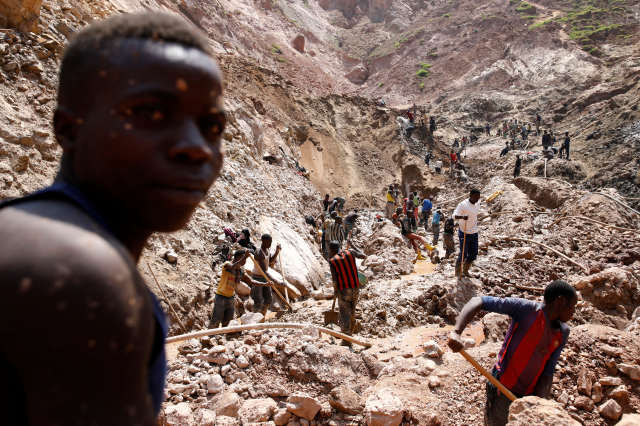|  | Know better. Do better. |  | Climate. Change.News from the ground, in a warming world |
|
| | Conflict in DRCIn eastern Democratic Republic of Congo, minerals lying underground are helping to fuel the deadly fighting above it.
The Rwanda-backed M23 rebels have surged through the region, taking the city of Goma and with it a province full of gold, coltan and tin mines.
The conflict has complex causes stemming from the aftermath of the Rwandan genocide 30 years ago. But the illicit trade for valuable minerals - critical to modern technology and the energy transition – is a significant driver.
As Jo Gill reports, a U.N. report late last year said M23 rebels were making an estimated $800,000 in monthly taxes from the production and trade of coltan, which is refined into tantalum.
Congo is the world's top producer of coltan, concentrated in the east of the country. About 80% of the world’s coltan reserves are thought to be in Africa, and 80% of that in the DRC.  Labourers work at an open shaft of the SMB coltan mine near the town of Rubaya in the Eastern Democratic Republic of Congo,
August 13, 2019. REUTERS/Baz Ratner |
Designated a critical mineral by the United States and European Union, tantalum is used in technologies like mobile phones and renewable energy systems.
DRC's mineral wealth is estimated at $24 trillion, but most of the minerals are in the east, where armed groups, including the M23, have seized control of mines. Rwanda has long denied supporting M23.
Often referred to as a "resource curse", many African nations have seen these minerals fuel conflict and corruption, leaving local people with little to show for it.
Yet as the world becomes increasingly digital, and countries shift towards clean energy technologies, demand for such critical minerals is set to surge. |
A global raceThe escalation of conflict in eastern DRC has placed renewed focus on the supply chain of metals for technology, with manufacturers under increased scrutiny to ensure their minerals are conflict-free.
Since the M23 advance, the EU has come under pressure to put a minerals deal with Rwanda on ice.
Last December, the DRC filed criminal complaints against Apple subsidiaries in France and Belgium, accusing the tech firm of using conflict minerals - claims which Apple strongly disputes.  Displaced people wait along the road for transport
back to their villages, days after the M23 rebel group seized the town of Goma, near Goma, in North Kivu, Democratic Republic of the Congo, February 3, 2025. REUTERS/Arlette Bashizi |
Beyond only the conflict-hit region, a global geopolitical race has begun to secure a stable supply of strategic resources for the energy transition, from cobalt to lithium.
The United States and European Union are trying to catch up with a dominant China - whose firms largely dominate supply from the DRC and mines in other mineral-rich parts of the world.
Like in the DRC, many communities in these regions are not seeing the fruits of their labour, and often suffer from consequences like pollution and lost ancestral lands.
As the energy transition helps to trigger even greater exploitation of mineral resources, will communities benefit or be left in the dust?
See you next week,
Jack |
|
|
| | M23 rebels' advance in mineral-rich eastern Democratic Republic of Congo puts green minerals rush in the spotlight | New regulation frees agribusinesses from greenhouse gas emission caps, but sets the ground to fund forest protection | Verification holds up carbon credit payments and "greedy" middlemen take a big cut, leaving little left for farmers, experts say | |
| |
| | | |
|